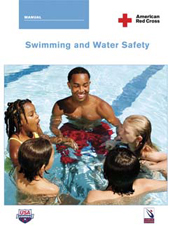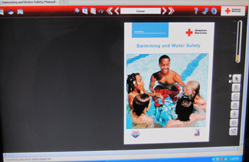Below is a transcript of the Red Cross video of how to swim backstroke, for my students to enhance their learning.

(This is a description of racing backstroke, the competitive stroke, not elementary backstroke.
“Back Crawl” is the name often used in Red Cross materials about racing backstroke.)
First, to be able to understand vocabulary about swim strokes, a transcript of the video section on stroke mechanics :
“Stroke mechanics are the basic elements of each stroke–body position, breathing and timing, arm stroke and kick. The focus of stroke mechanics is on making the most of propulsive movements while maintaining efficient body position and good body alignment. There are several terms you should understand before we begin studying individual strokes.
Body roll relates to the body position. It is the rotation of the body around the mid line–an imaginary line that runs down the center of a swimmer’s body. This rotation is important in the front and back crawl.
The power phase is the part of a stroke where the arm or leg moves the body in the right direction. The power phase of the arm stroke has three parts–the catch, the mid-pull and the finish.
The pitch refers to the angle of the hands as they move through the water. A good swimmer can feel a change in pitch because the water flow over the hand is different whenever the angle of the hand changes.
The recovery is the part of the stroke where the arms and legs relax and return to their starting position. Some strokes may also have a glide–a part of the stroke when the body keeps moving without any effort from the swimmer.
No two swimmers perform a stroke exactly the same way. You may need to adjust part of a stroke because of individual differences in body type, strength or flexibility. Understanding the basic elements of each stroke is the key to becoming a better, more efficient swimmer.”
Next: the transcript of the Red Cross video of how to swim backstroke.
(The video refers to freestyle using the Red Cross term “front crawl.”)
The back crawl or back stroke is the only competitive stroke performed on the back. Like the front crawl, efficient movement and good body position make this stroke more powerful. Keep your back slightly rounded so your legs are horizontal and your upper body is relaxed. Your hips and legs are just below the surface. The water line typically runs from the middle of the top of your head to the tip of your chin with your ears underwater. Keep your head still and aligned with your spine as you stroke. An effective back crawl depends on good body roll with every stroke.
Use a regular breathing pattern as you swim; inhale when one arm recovers; exhale when the other recovers. Your body continues to rotate as your recovering arm enters the water. Body rotation is at its maximum at the start of the catch. The catch for one arm begins as the other arm recovers–this will help you maintain good opposition rhythm in your stroke.
Your arms move in constant opposition to each other–one arm pulls while the other recovers. Each arm is always opposite the other arm. This is called opposition rhythm. Begin with your arm straight without moving your head. As your arm enters the water, rotate your body toward that side. Your hand enters the water just outside the shoulder, little finger first. Your palm faces out with the wrist slightly bent. Your entry hand slices downward eight to twelve inches, at a slight outward angle and grabs the water to begin the power phase.
The power phase looks like this–catch, mid pull and finish. The power starts with the catch. Bend your elbow so your finger tips are pointed toward the side of the pool. Your palm and forearm face toward your feet as you push the water back. Follow a straight path toward your feet while your fingertips continue to point to the side. During the finish, your hand speeds up as you follow through. Extend your wrist so your palm faces slightly down. At the end, your arm is straight and your hand is below your head. Be sure to keep pressing on the water through the finish to help your body rotate to the other side.
Begin the recovery for the arm stroke underwater. With your arm straight, lift your hand from the water first, letting the rest of your arm follow. The palm of your hand faces in. Your thumb leaves the water first. Keep your arm straight and relaxed throughout the recovery. Good body roll will help keep your recovering arm relaxed. Midway through the recovery, rotate your palm out so that your little finger enters the water first. Now watch the entire arm stroke sequence.
Use the flutter kick for the back crawl. It’s a continuous up and down movement that starts at the hip and snaps at the foot. Keep your ankles loose. During the upward kick, the motion begins at the hip. With a continuous fluid motion, straighten your leg and snap your foot up until your leg is straight and your toes just reach the surface. During the down beat, keep your leg relaxed and almost straight. The distance your legs move up and down during the kick will vary depending on the length of your legs, your hip and ankle flexibility, and the pace of the stroke. Most swimmers use the six beat kick, but your cadence may vary.
Now watch the back crawl again. Notice how all the elements of the stroke work together to create a smooth motion through the water.
When people first start to learn to float and then swim on their back,
many can attain a horizontal position in the water:

Even if your torso and legs become diagonal, with your toes touching the bottom of the pool, as long as your body is horizontal, with a slight arch in your back, you are floating correctly. See You CAN float for more.
At first, some people will find themselves in a position as if they are sitting in a chair, with their hips bent and dropping down in the water. With practice this is often quickly corrected, but can reappear later.
The Red Cross has notes about how most people progress as they learn backstroke :
Body position: Trunk horizontal to 30 degrees from surface; ears may be out of water, chin on chest; hips may be bent; rudimentary body roll; slight side-to-side motion between shoulders and hips
then:
Body horizontal to 15 degrees from surface; head back with ears submerged; rudimentary body roll; trunk and legs should be aligned
and then:
Body is nearly horizontal to surface in a streamlined position; head is still and aligned with body, no side-to-side movement; body roll is a fluid motion— head, trunk and legs are aligned.
Kick: Continuous kicking; occasional bicycling action acceptable; legs bent at knee acceptable; feet may break surface of water
then:
Continuous kicking that starts from the hips; legs slightly bent at the knee during upward kick and straight at knee with toes pointed during the downward kick; feet remain below the surface— moderate splashing acceptable
Arms: Above-water arm recovery—elbows below surface acceptable; hands may enter at or above shoulder level; arm straight at elbow during power phase acceptable
then:
Above-water recovery—arm may be partially bent at elbow; hands exit thumb-side or little-finger first; hands enter little-finger first about shoulder-width apart; arm partially bent at elbow during power phase; hand and forearm finish beyond hip
(It is common that when people are thinking about bending their arm underwater, the other arm does not stay straight in the air, but instead bends the same as the arm in the water.)
And finally, many people are able to keep their arm in the air straight while the arm in the water is bent.
Breathing and Timing: Occasional breath-holding acceptable; arms in opposition— hesitation at finish acceptable
then:
Rhythmic breathing pattern—inhales as one arm recovers and exhales as the other arm recovers; arms in continuous opposition—no hesitation at finish
You can watch the video at the Red Cross swim teacher certification page. This video has more details than you can absorb in one viewing. My students who have seen it during classes multiple quarters in a row say they noticed something new each time. It can give you an introduction to the stroke, and/or new things to try, especially if you are already an accomplished swimmer.
To find the video go to
https://www.redcrosslearningcenter.org/s/candidate-water-safety
scroll down to the Videos section and click on Swimming and Diving Skills: Back Crawl (it runs just under five minutes).
If you use Firefox as your browser, you might get an error message: “No video with supported format and MIME type found.”
Google Chrome and Microsoft Edge work as browsers.
If you would like to do some reading about swimming strokes, or swimming in general,
try the American Red Cross Swimming and Water Safety Manual.
Its public libraries number is 797.
This is the text for the Red Cross swimming teacher certification Water Safety Instructor.
A description of freestyle starts on page 116, backstroke on page 121, breaststroke on page 124, butterfly on page 128, elementary backstroke on page 133 and sidestroke on page 137.
It might be still downloadable for free. Go to
https://www.redcrosslearningcenter.org/s/candidate-water-safety
scroll down to Participant Materials and click on and open Swimming and Water Safety Manual.


(The American Red Cross Swimming and Water Safety Manual had no index, so I wrote one:
Swimming and Water Safety 2009 index).
The Cooper 12 minute swim test, which we do in my higher level swim classes, is on page 192, where it says “The 12-minute swimming test, devised by Kenneth Cooper, M.D., is an easy, inexpensive way for men and women of all ages to test their aerobic capacity (oxygen consumption) and to chart their fitness program.”
How can I tell if I’m a good swimmer? has more tests
Or should we call that page, how can I tell if I’m a fast swimmer?
See also: common errors in freestyle swimming
Freestyle swim video transcript
Butterfly swim video transcript


